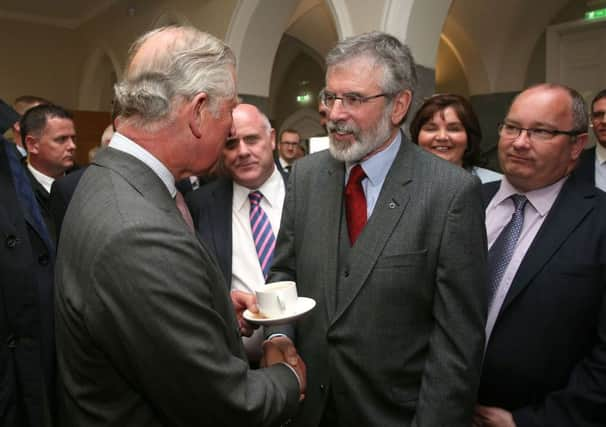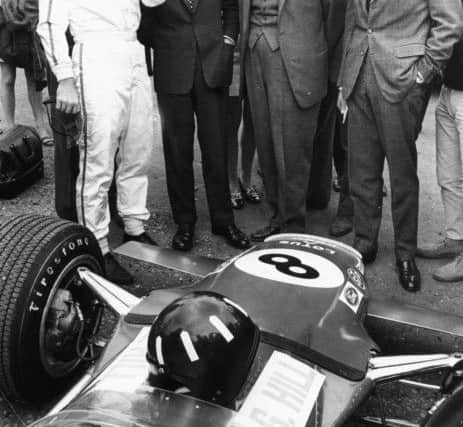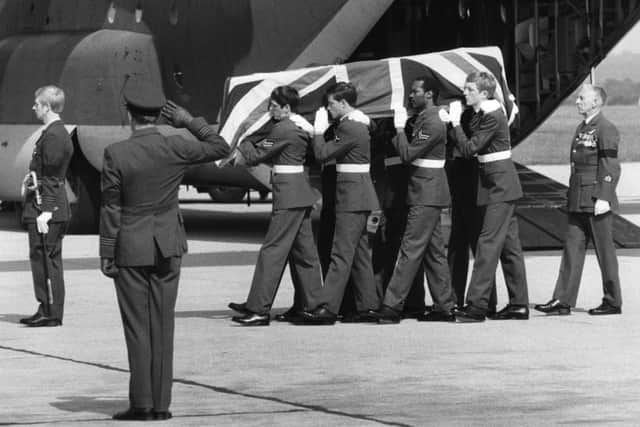Prince Charles in historic handshake with Gerry Adams


Prince Charles today shook hands with Sinn Fein president Gerry Adams on a visit to Ireland that will also see him visit the spot where the IRA assassinated his great-uncle.
The Prince of Wales became the first member of the Royal Family to greet a Sinn Fein politician in the Irish Republic in an encounter that symbolised reconciliation following the bloodshed of the Troubles.
Advertisement
Hide AdAdvertisement
Hide AdThe historic gesture was made at a reception in Galway the day before the prince travels to the seaside village of Mullaghmore, Co Sligo, for an emotional pilgrimage to the scene of the murder of his great-uncle and mentor Earl Mountbatten.


Today’s meeting between Charles and a leader of Sinn Fein, the political wing of the IRA, at the National University of Ireland would have been unthinkable a few years ago.
As a republican party fighting for a united Ireland, Sinn Fein’s view of the British Royal Family has been unapologetically hostile in the past.
And the killing of Lord Mountbatten by the IRA in 1979 had a profound effect on Prince Charles, who lost a close confidante and someone whom he regarded as a second father.
Charles agreed to the meeting after a request by the Sinn Fein president.


The two men smiled at one another as they shook hands for several seconds and exchanged words in a packed hall during the first engagement of his four-day visit.
Charles was holding a cup and saucer of tea when he met Mr Adams, who leaned forward to speak close to the prince’s ear several times.
He then introduced the prince to the man standing next to him, before Charles continued down a line of assembled dignitaries.
Advertisement
Hide AdAdvertisement
Hide AdMr Adams is the most senior republican to meet the Prince and the moment comes after his party colleague Martin McGuinness, the Northern Ireland Deputy First Minister and former IRA commander, shook hands with Charles at a state banquet in Windsor Castle last year and met the Queen in 2012.
At the opening engagement the prince and the Duchess of Cornwall were welcomed by traditional Irish dancers and enjoyed a tour of Irish crafts and fare, and also saw first-hand some of the work of the university in medical research and the arts.
Charles told a crowd of more than 100 invited guests, dignitaries and politicians that it was a “very great pleasure” to be in Galway.
He started his remarks with “a dhaoine uaisle”, the Irish equivalent of “ladies and gentlemen”.
The prince said he “may be a little too old to learn the steps of the Irish dancing routine” before adding that “having been an admirer of Fred Astaire ever since I can remember, it would be marvellous if I could”.
He added: “Having first had the privilege of coming to Ireland in 1995 and then again in 2002, each time I have been so overwhelmed and so deeply touched by the extraordinary kindness, the welcome and indeed, the fun of being in Ireland.
“Apart from anything else, the chance of plenty of good jokes and laughter make the whole difference to life.”
Despite his determination to accentuate the positive, it was impossible to avoid the poignant nature of the prince’s trip or forget the difficult past Anglo-Irish relations.
Advertisement
Hide AdAdvertisement
Hide AdToday Charles will take part in a walkabout in the seaside village of Mullaghmore, where Lord Mountbatten was killed.
The 79-year-old cousin of the Queen was targeted by the IRA as he set off with his family and a local teenager to gather lobster pots and fish for shrimp 600 yards from the harbour of the normally peaceful fishing village.
Lord Mountbatten was murdered along with Lady Doreen Brabourne, the 83-year-old mother-in-law of the earl’s daughter; his 14-year-old grandson Nicholas Knatchbull; and 14-year-old Paul Maxwell, from Killynur, Enniskillen.
Today’s handshake was in keeping with the theme of peace and reconciliation at today’s prayer gathering in St Columba’s Church, Drumcliffe, Co Sligo, a few miles from Mullaghmore.
It is also being looked upon as the next phase in ever-deepening relations, friendships and bonds between the UK and Ireland.
After the handshake, Charles had a 20-minute private meeting with Mr Adams and Mr McGuinness.
Mr Adams described the meeting as a “big thing for him and a big thing for us”.
“I said ‘cead mile failte aris’ [welcome back]. I told him in Irish and English that it was good he was back in Ireland,” Mr Adams said.
Advertisement
Hide AdAdvertisement
Hide Ad“Today’s meeting with Prince Charles is a significant symbolic and practical step forward in the process of healing and reconciliation arising from the peace process,” said Mr Adams.
“He and his family were hurt and suffered great loss by the actions of Irish republicans. I am very conscious of this and of the sad loss of the Maxwell family whose son Paul was killed at Mullaghmore and I thank all involved, including Charles, for their forbearance.”
The Sinn Fein leader was then challenged by reporters on his repeated denials that he was in the IRA.
“I am completely honest in that,” Mr Adams said. “Why don’t we have a good day of it, my friend.
“Obviously the past has to be dealt with and we are up for doing that.”
Profile: The man steeped in IRA background who helped bring peace to Northern Ireland
The idea that Gerry Adams would be allowed within touching distance of a member of the Royal Family would once have been inconceivable.
Steeped in the tradition of violent Irish republicanism, the Sinn Fein president has spent much of his life fighting the British state.
Advertisement
Hide AdAdvertisement
Hide AdAs one of the key republican figures during the Troubles, he was interned twice in the 1970s and is alleged to have been one of the first to volunteer for the Provisional IRA.
Over the years Mr Adams has been forced to repeatedly deny that he was one of the leading lights in the terrorist organisation.
His status within the republican movement was recognised in the 1970s when he took part in secret talks with then home secretary William Whitelaw that attempted to negotiate an IRA ceasefire.
By the 1980s he was becoming more involved in politics and became vice-president of Sinn Fein, the political wing of the IRA.
He played leading role in campaign to give IRA prisoners political status after they went on hunger strike.
In 1983 he was elected president of Sinn Fein and won a seat in parliament as MP for Belfast West, which he has always refused to take up on the grounds that his party should not swear allegiance to the Queen. As the peace process developed Mr Adams was a key negotiator in the talks that led to the Good Friday Agreement of 1997. He also played a prominent role in the Northern Irish political settlement that saw Sinn Fein enter a partnership with the Democratic Unionist Party. His decision to meet Prince Charles has been criticised by some ardent republicans – an indication that he, as well as the Royal Family, have had to travel a great distance for Today’s meeting to go ahead.
Perhaps that’s why he could not resist pointing out that the Prince of Wales is the Colonel-in-Chief of the Paras, the regiment blamed for the Bloody Sunday massacre in Londonderry in 1972. “Prince Charles is Colonel-in-chief of the Parachute Regiment, a unit of the British army responsible for killing many Irish citizens, including in Derry, Ballymurphy, Springhill and other communities across the north,” the Sinn Fein president said. But at the same time he also acknowledged that the murder of Lord Mountbatten meant Charles had been “bereaved by the actions of republicans”.
Background: The day IRA killed Mountbatten to make its political point
Advertisement
Hide AdAdvertisement
Hide AdThe assassination of Lord Mountbatten by the Provisional IRA in 1979 was a grievous blow to Prince Charles, who lost one of his closest confidantes.
It was also one of the most shocking incidents of the Troubles and came during a particularly brutal part of the Provisional IRA’s terrorist campaign.
The 79-year-old Earl Mountbatten of Burma was on holiday when he was killed. A bomb secreted aboard his boat blew up off the coast of Mullaghmore, Co Sligo, in the Republic of Ireland – the small fishing village where he had holidayed for many years.
Nicholas Knatchbull, 14, one of his twin grandsons, died alongside him as did Paul Maxwell, 15, a local boy. Another passenger, the Dowager Lady Brabourne, 82, died the day after the attack. Prince Charles was devastated by the tragedy..
Despite security advice, Lord Mountbatten went lobster-potting and tuna fishing in his wooden boat. Unbeknown to him, IRA member Thomas McMahon had slipped on to the unguarded boat that night and attached a radio-controlled 50lb (23 kg) bomb. The device was detonated by remote control at 11:39am when the boat was about 200 yards from the harbour.
The IRA quickly admitted carrying out the bombing, saying it was designed to “bring to the attention of the English people the continuing occupation of our country”.
At the time, Mr Adams said: “The IRA gave clear reasons for the execution. I think it is unfortunate that anyone has to be killed, but the furore created by Mountbatten’s death showed up the hypocritical attitude of the media establishment.
“As a member of the House of Lords, Mountbatten was an emotional figure in both British and Irish politics. What the IRA did to him is what Mountbatten had been doing all his life to other people; and with his war record I don’t think he could have objected to dying in what was clearly a war situation.”
Advertisement
Hide AdAdvertisement
Hide AdA few hours after the murder, 18 soldiers died in IRA ambushes at Warrenpoint on the other side of the border.
McMahon was jailed for Lord Mountbatten’s murder, but was later released under the terms of the Good Friday Agreement.
Analysis: There was more to handshake than the desire to heal wounds
Prince Charles and Gerry Adams’ 13-second-long handclasp was the first between the Sinn Fein president and a member of the royal family and the political significance of the moment belied its brevity.
The heir to the British throne has first-hand experience of Irish republican violence. Today, Charles will go on a walkabout in the seaside village of Mullaghmore in County Sligo. Here, in 1979, Charles’ great uncle Lord Mountbatten was killed when a remotely controlled IRA bomb ripped through his boat. Within hours, another IRA bomb claimed the lives of 18 British soldiers in Warrenpoint. Adams is widely believed to have been at the helm of the IRA at the time of Mountbatten’s murder. Today was a milestone in Anglo-Irish relations, and yet another indication of how much Irish politics has changed since the signing of the Good Friday Agreement.
But Adams’ decision to meet Charles is not motivated solely by an altruistic desire to heal the wounds that still exist in Irish society. The boycott of the very successful 2011 royal visit to the Republic of Ireland played badly in middle class constituencies in which Sinn Fein hopes to make electoral gains. Reaching out to the royals will, Adams hopes, cement their journey from the political wilderness to the heart of government in Dublin. There are, however, risks in the royal embrace. Anti-Sinn Fein sentiment is rising in republican heartlands. Earlier this month Sinn Fein saw its vote fall across Northern Ireland, losing a seat in Fermanagh/West Tyrone.
While the prince and Gerry Adams were exchanging pleasantries in Galway today, relatives of civilians killed in the so-called Ballymurphy Masscare when members of the Parachute Regiment opened fire in west Belfast in August 1971 lined up outside Belfast City Hall. Among the protesters was the Sinn Fein MP Paul Maskey, a sign that while the republican movement is winning plaudits from the world’s media it fears losing ground on its home turf. Peter Geoghegan